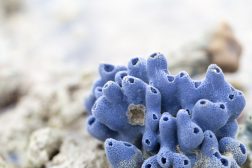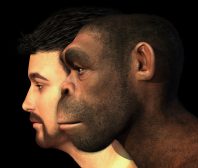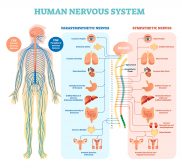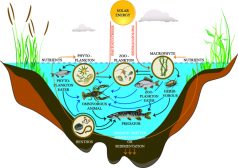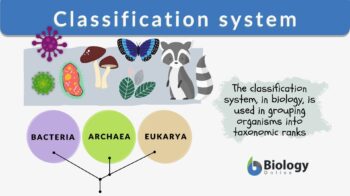
Classification system
n., plural: classification systems
[ˌklæsɪfɪˈkeɪʃən ˈsɪstəm]
Definition: the systematic placement of organisms into groups or taxonomic rankings
Table of Contents
Classification Systems Definition
In life, many things are classified, that is, to put into categories or groups based on their characteristics. Of course, biology, being the study of life and living things, also has an order of classification. The classification of living things helps us in many ways to organize and group organisms based on their characteristics.
To further delve into this system, we must first define it. What is a classification system? How would one define a classification system? The classification system is the system used for the scientific classification of organisms and other activities in science based on the characteristics, behaviors, and methods used.
Would you like to understand how classification system works? Join us and participate in our Forum discussion: What is phylum chordata? Our community may be able to help!
There are different types of classification systems and they are all used for different purposes. Organism classification takes place in the form of a taxonomic system. This is called the Linnean classification. The Linnean classification involves the usage of the grouping organisms using a hierarchy called taxa. This animal classification system contains taxonomic levels and taxonomic groups that animals are placed in based on their features and even shared ancestry.
These levels of biological classification are as follows:
Species » Genus » Family » Order » Class » Phylum » Kingdom » Domain
These were listed from the least inclusive to the most inclusive. Figure 1 below shows the taxonomical ranking.
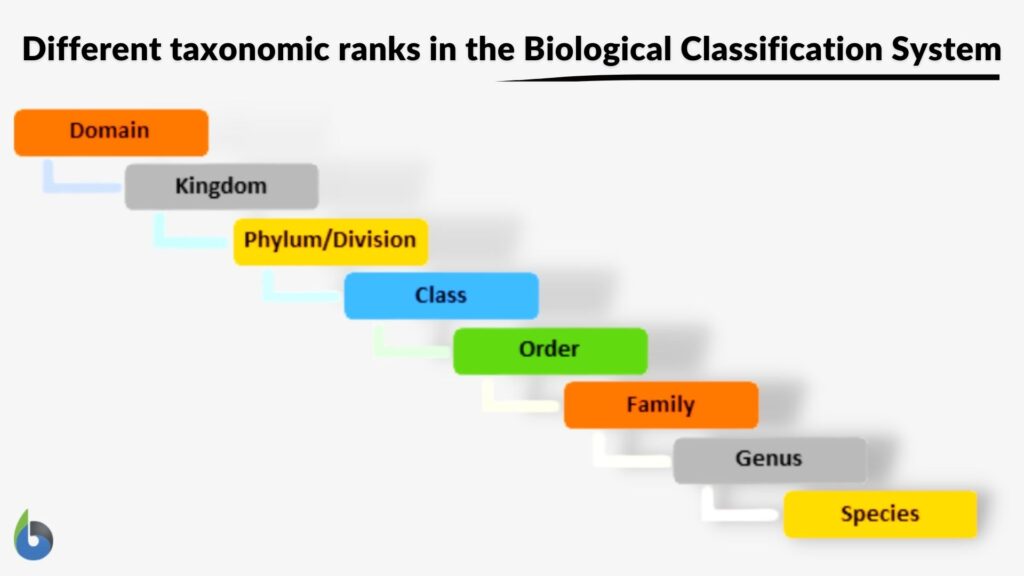
The classification system is a system for classifying things, particularly, the collection of procedures, characteristics, and definitions used to classify and/or identify things. The levels of biological classification are as follows: Species » Genus » Family » Order » Class » Phylum » Kingdom » Domain (from least- to most-inclusive).
Levels of the Classification System
The classification of organisms takes place in the different taxonomic levels. They will be defined and listed according to their inclusiveness in groups.
Domain
The domain classification is the highest level of taxonomic classification in the organism classification system. The domain can be broken down into three types: Archaea domain, Eukaryotic domain, and the (Eu)Bacteria domain. These can be seen in Figure 2 below. These individual domains are based on their evolution over the years and the different attributes they contain.
Bacteria are also known as prokaryotes as they have no intracellular organelles and do not contain a nucleus. Archaea, though similar to bacteria are quite different. They are genetically distinct from each other. Last but not least, eukarya is the last domain. The organisms that belong to this domain have membrane-bound organelles and nuclei. This makes them easier able to complete tasks and be more efficient as they have divided the tasks among different organelles, making them specified.
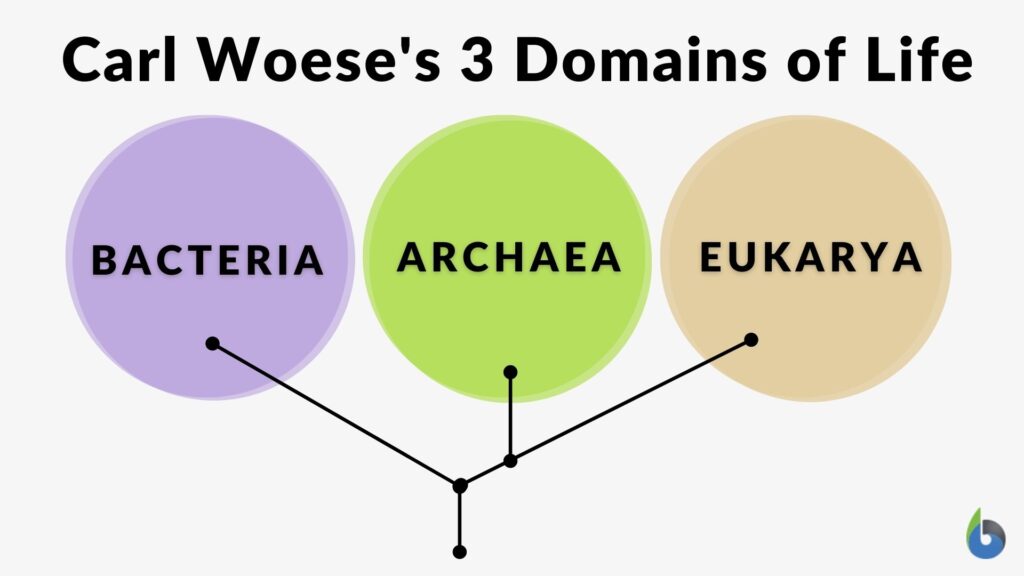
Kingdom
The kingdom classification is the second-highest ranking in the taxonomic groupings of organisms. How many kingdoms are there? There are five kingdoms, though some recent studies have claimed six and seven kingdoms. The five kingdoms consist of the animals, plants, fungi, protists, and monerans.
The kingdom Animalia is the most diverse out of the kingdoms and this is because it has evolved the most. This kingdom is generally divided into invertebrates and vertebrates (animals that have a backbone and those that do not).
Chordates are animals that belong to Kingdom Animalia. Join us and participate in our Forum: What is phylum chordata? Learn more about them today!
The kingdom Plantae is made up of all trees, flowers, bushes, and vegetation. It is the oldest of all the kingdoms. Its members are characterized by having limited movement, eukaryotic features, and autotrophic abilities.
Yeasts, toadstools, molds and mushrooms belong to the kingdom Fungi. These organisms are carnivores that have chitin in their cell walls yet reproduce in a sporic manner.
Protista can be considered the mother of all eukaryotes as all of them are descendants of this kingdom. It can be a very difficult kingdom to distinguish as it is intertwined with many of the others. The monera kingdom consists of all archaea and bacteria as it deals with all microscopic organisms. The kingdoms can be clearly seen in Figure 3 below.
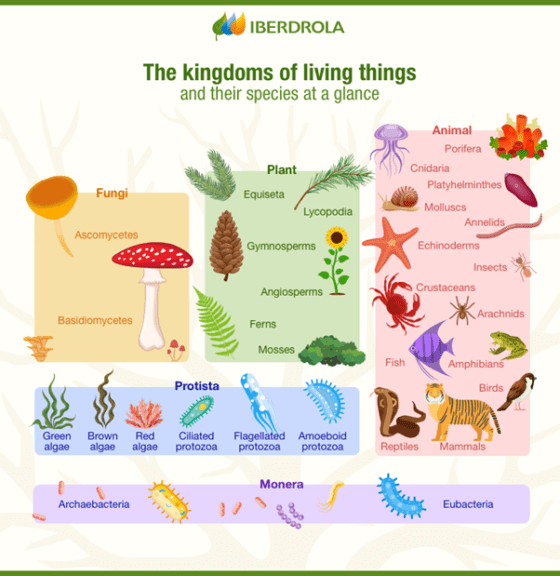
Phylum
In the kingdom-phylum ranking system, the next classification is phylum. This taxonomic rank, sometimes termed as “division” lies after the kingdom and further classifies based on phenetic and phylogenetic. Phenetics is based on the number of shared characteristics using a numerical system and phylogenetics is based on evolution and shared relationships but using a systematic study. Each kingdom is broken down into numerous phyla. This can range from as few as four like in Kingdom Protista to as many as the nine phyla that kingdom Animalia contains.
Class
The class falls just between the phylum and order classifications. Just like kingdoms contain multiple phyla, each phylum can contain multiple classes. These generally end with the suffix “ae” when they are named. Sometimes, if classes are very large, they may be divided into subclasses.
Order
Order is the classification that consists of several families. Orders above the family classification and below the ranking of classes. An order consists of multiple families that share many characteristics and evolutionary traits.
Family
When a group of genera with similar characteristics and traits are pulled together it is called a family. The family is the ranking between orders and genus in the Linnean classification. Multiple genera make up a family group.
Genus
Genus is the systematic unit in the organism classification that helps determine the species of organisms as the genus groups multiple species together. A genus could also consist of one unusual species whose attributes are so unique it is classified on its own.
Species
Species classification is the final ranking for the biological classification of living things. A species is defined as a group of organisms with similar characteristics that are able to procreate or interbreed with one another. The offspring they produce must be sustainable and also being able to create a new generation of the species as well. Sometimes, species can form evolve into another, this is known as speciation. Figure 4 above shows the speciation of the Galapogos Finches.

Examples of classification systems
The classification of systems is used to scientifically name organisms based on genus and species. For instance, the scientific name for humans is Homo sapiens sapiens. “Homo” coming from the genus and “sapiens sapiens” being the species.
All organisms can be classified based on the classification system. For instance, a simple household pet such as a cat. A cat would belong to the domain eukarya, being a multicellular organism. This would be further divided into the kingdom Animalia as a cat is obviously an animal. Being an animal that has a flexible rod that supports its backbone, it would be a member of the phylum Chordata.
Phylum Chordata – a phylum consisting of all chordates. Find out which animals belong in this group: What is phylum chordata? Join now!
The class of the domestic cat would be Mammalia being an organism that carries its young in a womb and also lactates to feed its offspring. The house cat then follows the path of being a member of the order Carnivora and the family of Felidae. Finally, we come to the genus, which in this case is Felis and the species is catus. So a cat, using the classification system is called Felis catus.
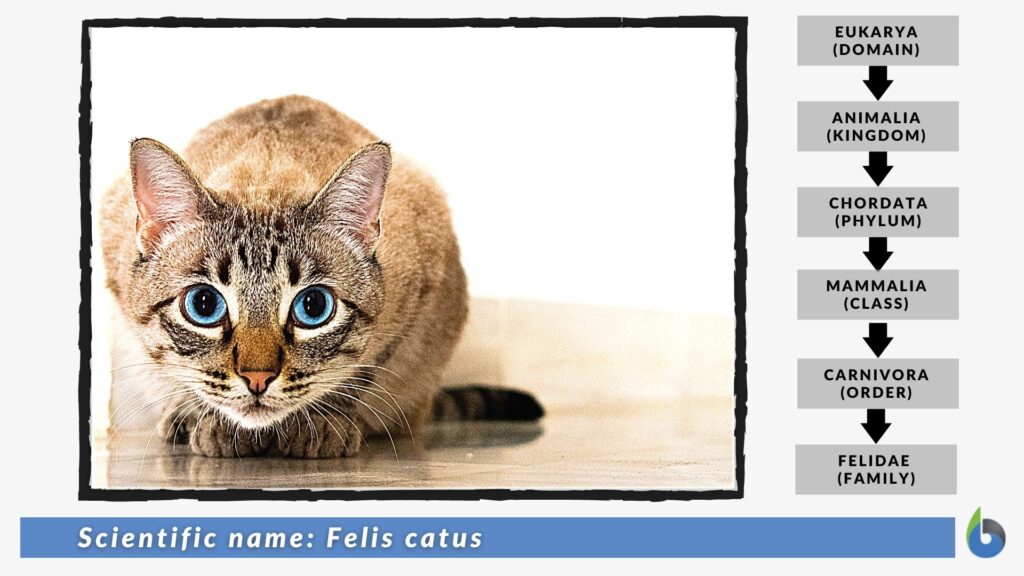
Try to answer the quiz below to check what you have learned so far about the classification system.
Reference
- Biology Dictionary Editors. (2019). Domain. Biology Dictionary.
- Biology Online. (2021). Classification System Defintion. Biology Online. https://www.biologyonline.com/dictionary/classification-system
- Biology Online. (2021). Phylum. Biology Online. https://www.biologyonline.com/dictionary/phylum
- Carr, S. (2019). Phenetic vs Phylogentic classification of birds. MUN. https://www.mun.ca/biology/scarr/Phenetic_vs_Phylogenetic_classification_of_Birds.html
- CDN. (2021). Taxonomy of the cat. CDN. https://cdn.citl.illinois.edu/courses/ANSC207/week1/Domestication/web_data/file12.htm
- Gittleman, J. L. (2019). Species. Encyclopedia Britannica. https://www.britannica.com/science/species-taxon
- Iberdrola. (2021). Biology 5 Kingdoms of Living things. Iberdrola. https://www.iberdrola.com/sustainability/biology-kingdoms-living-things-classification
- Scitable. (2014). Species. Nature Education. https://www.nature.com/scitable/definition/species-312/
©BiologyOnline.com. Content provided and moderated by Biology Online Editors.

